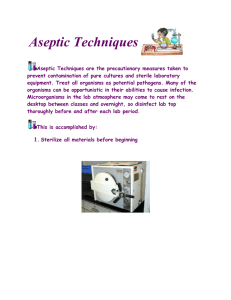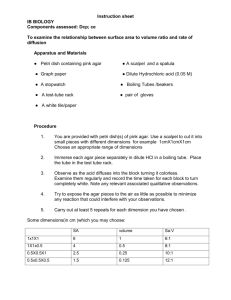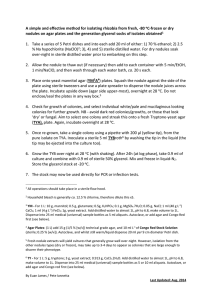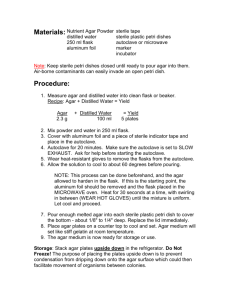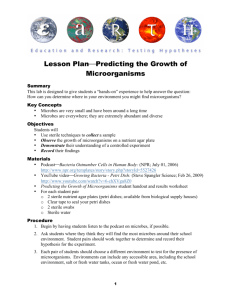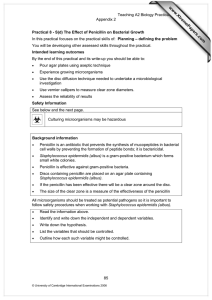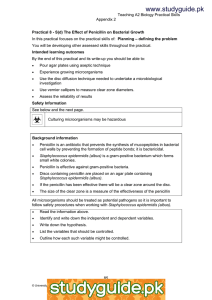Aseptic Technique: Media and Equipment
advertisement
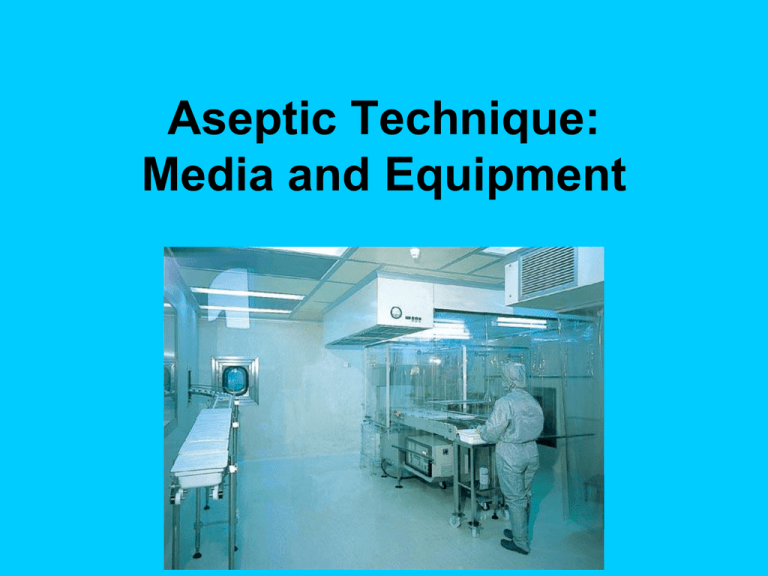
Aseptic Technique: Media and Equipment Growth Medium • A growth medium or culture medium is a liquid or gel designed to support the growth of microorganisms or cells • The most common growth media for microorganisms are nutrient broths and agar plates Defined Media • An important distinction between growth media types is that of defined versus undefined media • A defined medium will have known quantities of all ingredients Undefined Media • An undefined medium has some complex ingredients that consist of a mixture of many chemical species in unknown proportions • Undefined media are sometimes chosen based on price and sometimes by necessity - some microorganisms have never been cultured on defined media. Undefined Media • We will use this in the lab • Nutrient Agar contains: – Pancreatic digest of gelatin – Beef Extract – Agar Forms of Culture • The most common growth media for microorganisms are nutrient broths (liquid in a test tube) • Liquid media are often mixed with agar and poured into petri dishes to solidify • These agar plates provide a solid medium on which microbes may be cultured. They remain solid, as very few bacteria are able to decompose agar. Slants • There are several reasons a slant is best for culture storage: • 1) Surface area – slant increases it • 2) Size – test tubes smaller to store • 3) Moisture – won’t dry out • 4) Ease – once the microorganism is transferred, you can store it for up to 6 months in a refrigerator Aseptic Technique • Aseptic technique refers to a procedure that is performed under sterile conditions • This includes medical and laboratory techniques (such as with microbiological cultures) • It includes techniques like flame sterilization (Bunsen burner) Aseptic Technique • Sterile surfaces must be protected from microbes in the air or on non-sterile surfaces • In sterile technique, only sterile surfaces touch other sterile surfaces and air exposure is kept to a minimum Aseptic Technique • It is important in microbiology to work with pure cultures • This is difficult because the world around us is covered with MO’s (even on dust particles in the air) • In order to protect broth, plates, slants and pure cultures from MO’s around us, we practice aseptic techniques Aseptic Technique • In this class you will need to practice sterile technique when we inoculate a pure culture into fresh medium (tube of sterile broth or an agar plate) Aseptic Technique • “A” = Negative prefix • “Septic” = Infection • All techniques and procedures which prevent contamination. Safe Patterns • Safe patterns include: – Standard Lab Rules – Inoculating Techniques – Use and Disposal of Equipment – Washing Hands Safe Patterns • Sterilize all materials before beginning Safe Patterns • Spray the lab top down with a commercial disinfectant or a 10% bleach solution and allow this to stand for a minute. You may then wipe down the bench with the paper towel. Safe Patterns • Wash hands before and after lab. Safe Patterns • You should have only the materials you'll need and the written lab procedures on your bench top or desk. Safe Patterns • Keep petri dishes and test tubes covered as much as possible. • If top must be removed completely do not LAY IT on the lab top. This lowers the probability of contamination and prevents “false positive” results. Safe Patterns • Hold bottles and tubes at an angle to minimize the amount of airborne microbes that can fall into them (blue circle). Remove the caps as shown above and do not set the caps down. Keep the mouth of the facing cap down (red circle). Safe Patterns • When using metal inoculating loops, HEAT the entire piece of metal of the inoculation instrument in the flame: it should be RED HOT. Be sure to COOL your inoculation instrument before picking the inoculum (broth or agar). Safe Patterns • To inoculate a Petri plate: Lift one edge of the Petri plate cover to gain access to the culture medium. Keep the cover over the plate bottom to prevent dust and microbes from falling onto the agar. Safe Patterns • Report spills to me immediately • Cover the spill with paper towels and squirt disinfectant onto the towels. Wait 20 minutes then clean up the spill. Safe Patterns • Label all test tubes and petri plates with your name (initials), date, and name of organism BEFORE you add any solutions, bacteria, etc. Safe Patterns • Do not dump ANY microbial suspension down the drain or in the trash can. I will collect them for proper disposal. Safe Patterns • Place test tubes in racks when working at your table: never lay the tubes down—they leak. • Keep test tube caps and petri dish covers on media to reduce contamination (matters not whether it is sterile media or already cultured). Safe Patterns • All agar plates are incubated UPSIDE DOWN to reduce bacterial contamination and to reduce the possibility of water condensation that may be on the lid dropping onto the agar, causing fluid to run across the agar medium. Media • Sterilize after preparation, in storage, or working containers. Handle aseptically. • If no goofs – Sterile indefinitely E. Autoclave • Pressurized steam • Water boils at 100ºC, but if pressure is increased the boiling point rises – At 15 PSI the Boiling Point = 121ºC – At 20 PSI the Boiling Point = 126ºC • Minimum = 15 minutes @ 15 PSI • A pressure cooker is the same as an autoclave Boiling • 100ºC kills most MO, fungi, and viruses but a few are resistant. – Example: Inf. Hepatitis, Endospores • But very good nonprofessional use Equipment Technique depends on article: Does it burn or melt? Do you want it back? Equipment 1. Autoclave • If it fits into machine and won’t melt • 15 minutes @ 121ºC (15 PSI) minimum Equipment 2. Boiling • Never in a lab Equipment Oven • Dry heat used for metal and glass • 90 minutes @ 170ºC minimum Equipment Incineration – Burning • 1000ºC Plus • Loops, test tubes Equipment 5. Presterilized Equipment • Usually plastic and paper materials • Gas: Ethylene Oxide • Irradiation
